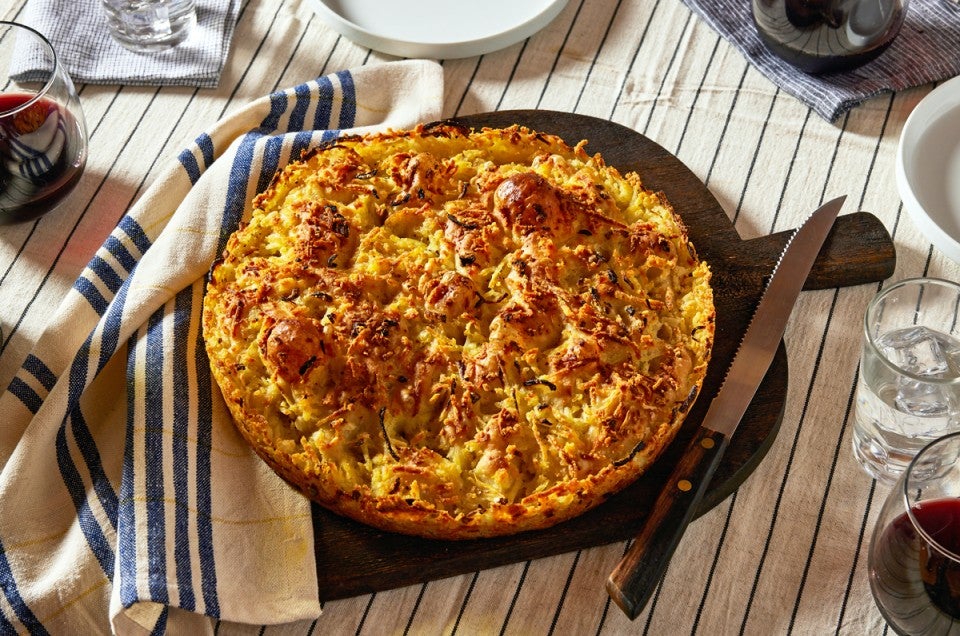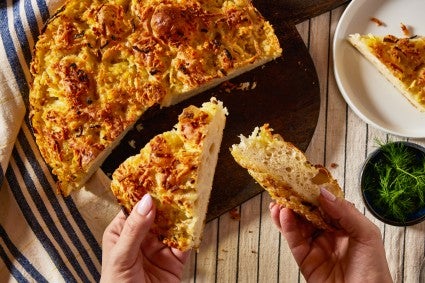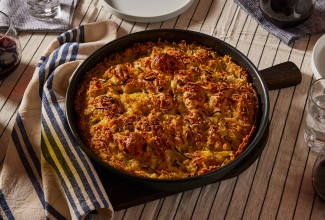The secret to our newest focaccia is frozen hash browns (and the microwave)
Latke Focaccia provides all the pleasure of a crispy potato pancake with half the fuss.


Crispy, golden latkes are one of the primary joys of Hanukkah, but they do not come without their pain points. First, of course, is the frying — oil is the point of Hanukkah, and so cooking the latkes in a deep pool of oil is non-negotiable. For some people, this is a bummer: Frying can be messy, and it can make your house smell like a fast food joint. Personally, I don’t mind the smell of fried foods; in fact, I find the smell sort of enticing, like an amuse-bouche — it gets my salivary glands going. I am less enthusiastic, however, about a step that comes before the frying: the grating — and then squeezing — of the potatoes.
The grating is required, of course, and so is the squeezing: Because there’s so much water in the potatoes, your latkes will splatter in the oil and turn out soggy and waterlogged if you don’t squeeze it all out.
I’ve long accepted that’s just how it has to be if you want latkes. And that’s fine — the result is worth it. But when it comes to my colleague Sarah Jampel’s new recipe for Latke Focaccia — an airy, bubbly focaccia (thank you, bread flour) that’s coated on both sides with crispy shredded potatoes — you get to skip both the grating and the squeezing (and, for that matter, the frying!). All thanks to a special ingredient you don’t often use in bread: frozen hash browns.

Sarah reached for frozen hash browns out of respect for everybody baking this bread. “I wanted to avoid asking people to grate a ton of potatoes!” she says. “The Latke Focaccia calls for a whopping 6 cups of potatoes, which would take a whole lot of time to grate. Frozen hash browns are just so convenient.”
Just like that, Sarah took away one of the pain points of latke (focaccia)-making. But there was still the issue of all the moisture in those potatoes. One common way to expel that liquid is to gather the shredded potatoes in a clean towel, twist it into a bundle, and squeeze enthusiastically until dry. Sarah eschewed that method — “it compromises the integrity of the individual shreds,” she says. (She cares!) So she went to the drawing board. At first she tried pre-cooking the hashbrowns in a frying pan. But this was time-consuming (you have to cook the potatoes in batches and then let them cool), and the hashbrowns cooked down so much that they practically disappeared into the bread.
Enter the microwave. By nuking the hash browns in one-minute increments, the potatoes not only thaw, but they also release a lot of their moisture as steam. A gentle pat with a clean towel finishes the job when they come out of the microwave. The dry, grated potatoes are then ready to be put to work: Two-thirds of them go on the bottom and sides of the pan; the rest get sprinkled on top of the focaccia dough. At the end of baking what emerges from the oven looks like a giant latke, and tastes like one too. And thanks to those hashbrowns, it took half the amount of work (and a lot less oil).
More latkes and focaccia:
Watch Martin Philip make a cheesy, small-batch focaccia on YouTube.
For latkes without the focaccia, try our sheet-pan latke recipe.
Want more gorgeous, celebratory breads for the season? Check out the full 2023 Holiday Breads lineup.
Cover photo by Rick Holbrook; food styling by Kaitlin Wayne.


